It’s hard to believe some of the things that our cycling ancestors got up to – and got away with! Here are some of our favourite misadventures.
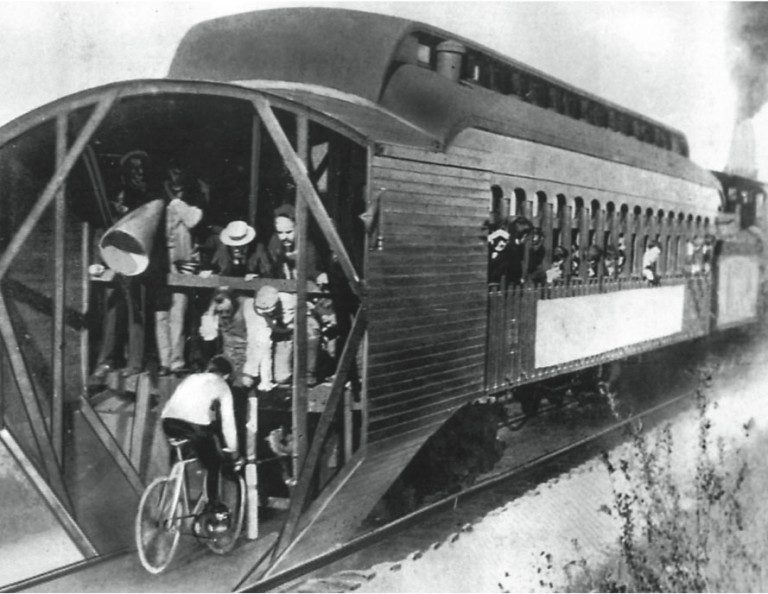
Mile-a-Minute Murphy
In 1899 Charles Minthorpe Murphy was the first person to ride a mile in under a minute. He did this by drafting a steam train.
Murphy laid a two-mile carpet of boards in the middle of rails and built 11-foot side-wings and a small roof to the back of the train.
The boards moved up and down as the train passed over them, causing Murphy to ride a ‘wooden wave’. The train laboured to get up to 60mph at first.
Murphy: “Within five seconds the rate of speed was terrific; I was riding in a maelstrom of swirling dust, hot cinders, paper and other particles of matter. The whipsaw feeling through a veritable storm of fire became harder every second. I could feel myself getting weaker every second I saw ridicule, contempt, disgrace and a lifetime dream gone up in smoke. I saw the agonised faces, yelling, holding out stretched hands as if they would like to get hold of or assist me somehow.”
Just before the finish line the train slowed, Murphy crashed into the back of the train and was pulled up on to the train and into relative safety by spectators.
A mile in 57.8 seconds.
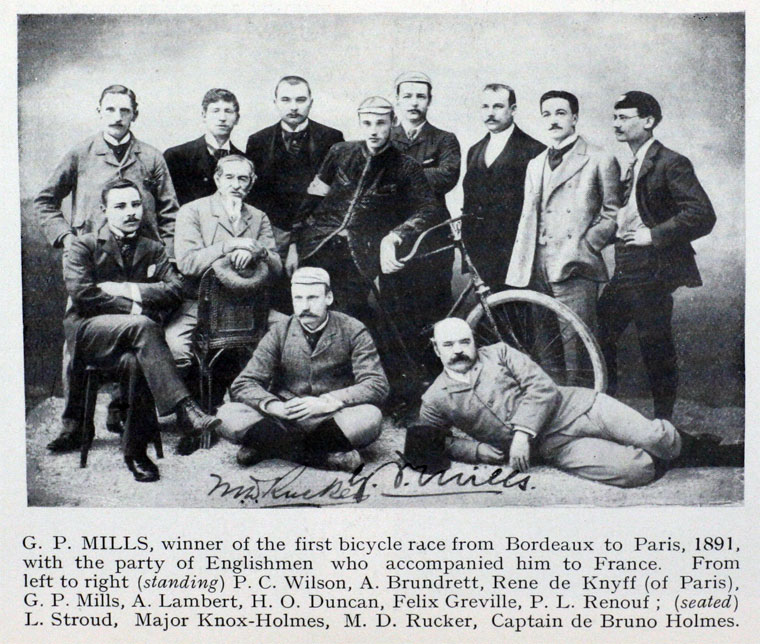
Land’s End to John o’Groats on a penny-farthing
In 1886 George Pilkington Mills (aged 18) rode from Land’s End to John o’Groats. Twice. Once on a tricycle and once on a penny-farthing. Riding virtually without sleep, “certainly no more than a wayside nod”. He set a world record which still stands to this day.
George was a bit special. He won the inaugural Bordeaux-Paris race in 1891. He once competed in three 24 hour events in the same week!
The most impressive commuter of all time
Harry Long was a commercial traveller who used a bicycle in the course of his business rounds which took him to every part of England and Scotland. In 1910 Harry covered 25,376 miles on his work rounds.
It was Harry’s feats that pretty much inspired the ‘Furthest distance cycled in a year’ record.
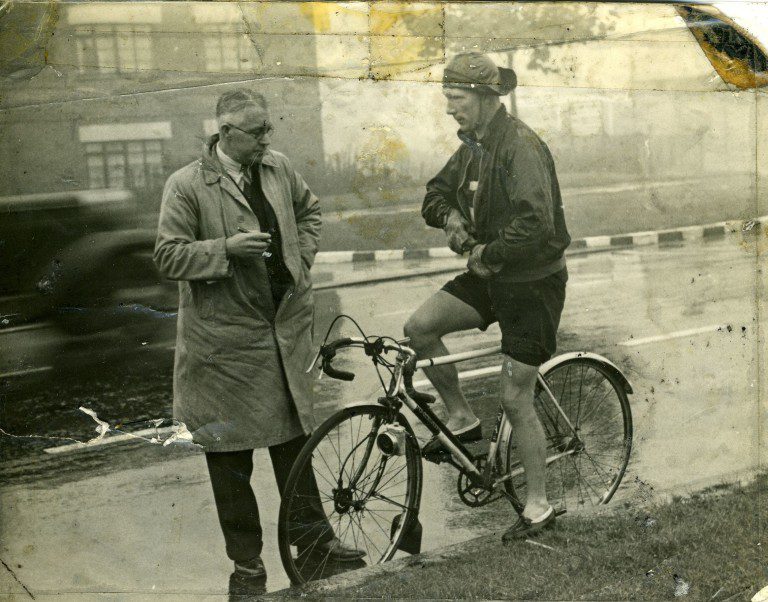
The untouchable Godwin
Some of you probably know this one already but there’s no way it can be missed out from this list.
In 1939 Tommy Godwin rode 75,065 miles in a single year.
75,065 miles.
His bike weighed more than 30 lbs. As WWII started he had to ride through black-outs with tape over his bike lights. He stuck to his vegetarian diet throughout.
He didn’t actually stop at 75,065 miles either. He kept going(!) and went on to set the 100,000 mile record too (500 days of riding).
After finally getting off his bike Godwin spent weeks learning how to walk again. He then went to war in the RAF.
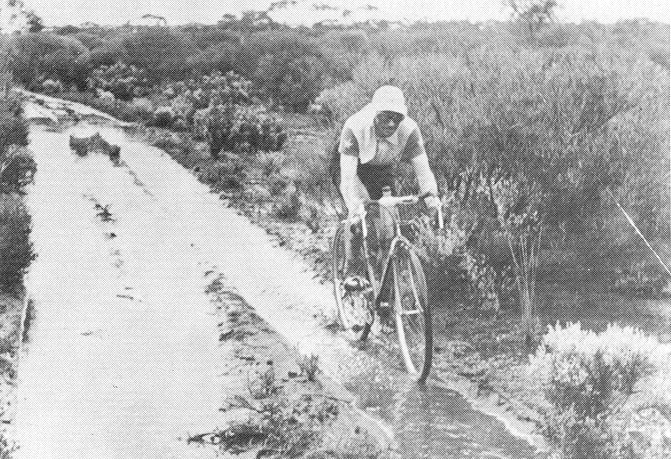
Oppy versus the snake
In 1937 Austrlaian Hubert Opperman broke – well, smashed – the record for riding from Fremantle to Sydney. 2,875 miles in 13 days and 10 hours.
The distance alone is impressive but factoring in the road conditions (rutted tracks, soft sand, scorching heat) it’s quite bonkers really.
Opperman: ” At one point, by the light of the car behind me, I could see a large snake in the wheel ruts, and I couldn’t stop. All I could do was land the bike on top of it, hard. I suppose I must have killed it. Then, at Nanwarra Sands, I had to pick up the bike and carry it for 10 miles in the soft sand. We learned that I could gain time by sleeping for only 10 minutes at a time, something I have never forgotten.”
Opperman, like George Pilkington Mills above, set dozens of cycling records in his career. It’s well worth reading more about his cycling feats.
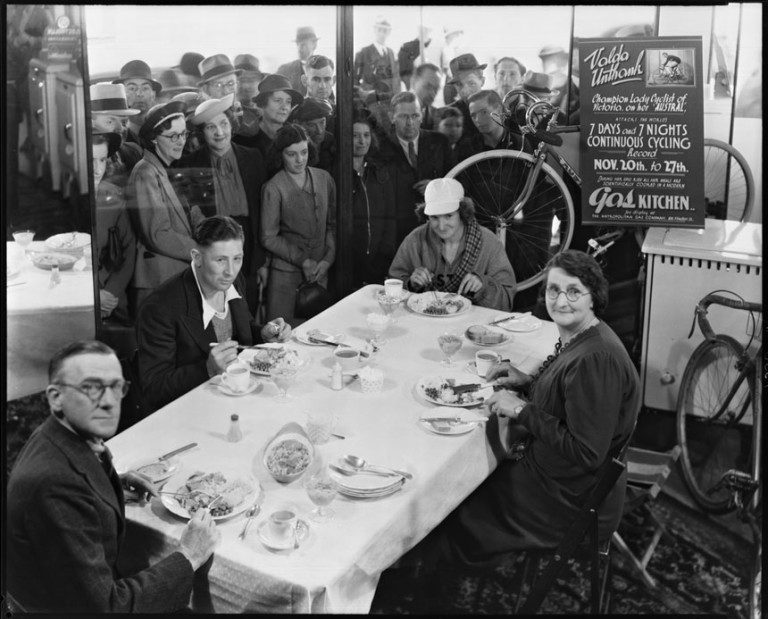
Valda Unthank the Paralysing Pedaller
Another mad Australian. The 1930s were a busy time for Australian record books – especially for female riders.
In 1938 the fabulously named Valda Unthank set three records during one bike ride: the Launceston to Burnie (and back). Valda not only set the record for the Launceston to Burnie return but she also set the Australain 200 mile record AND the Australian 12 hour record.
Her winning ride took place 11 days after a previous attempt where she had crashed the bike heavily on a sandy downhill bend, resulting in a stay in hospital.
Valda’s mum chaperoned her on the subsequent record breaking ride witnessed “a pain wracked Valda fight the clock, the elements her bike and her injuries, for twelve hours over two hundred miles, to claim her prize.“
Valda’s nickname was the Paralysing Pedaller.
Walter Greaves the teetotal one-armed communist vegetarian
Walter set the record for yearly distance in 1936. He rode 45,383 miles. In mainly hilly Pennine terrain. And he did it one handed. Walter lost his arm in some sort of accident as a boy (the details are rather confused).
His record attempt did not start well. His specially adapted bicycle was delayed in production causing his to start five days into the calendar year (the record must be done with a calendar year). The winter was an especially bad one with snow and ice lasting up until the end of February.
In July he collided with a car and spent two weeks in hospital.
Oh and as for the headline, growing up in an impoverished Bradford, Greaves developed an interest in communism and he apparently tried to get every young cyclist he met to join up to the young communists. He was also a committed teetotaller. He was also a vegetarian.
He was joined by thousands of cyclists in Hyde Park at the finale to his attempt. His fame had spread throughout the course of the year.
At that evening’s victory reception, he was offered champagne to celebrate and onlookers encouraged him with comments like “Go on… We won’t tell!” To which Greaves replied: “When I want to poison myself, I’ll do it with arsenic.”
Lakeland pass storming
AKA mountain biking between the wars.
Long before mountain bikes were invented there were a bunch of thrill-seeking cyclists dragging their fixed wheel bikes over the high passes in the Lake District. They’d ride bits of it but an awful lot of bike-carrying would be involved
A book from that era – The Lake District (Ward, Locke & Co.) states: “Those who are only acquainted with Honister, the Kirkstone, Whinlatter, Buttermere Hause, Dunmail Raise and even Wrynose and Hardknott are warned that for the most part, the passes are not metalled roads, or even cart tracks, but mountain paths, some of which are exceedingly rough and in places steep, e.g. the Sty, Coledale, and, worst of all, Rossett Ghyll.
“The others are emphatically not rideable. Many cyclists have carried their machines over Scarf Gap and even the Sty and Esk Hause, but that game is a thing apart and known as pass-storming”

Not to mention Enrico Totti, the one legged Italian cyclist who died in WW1. Not many extreme cyclists have their own statue I guess.
http://www.italofile.com/2014/09/09/italys-one-legged-cyclist-turned-war-hero/